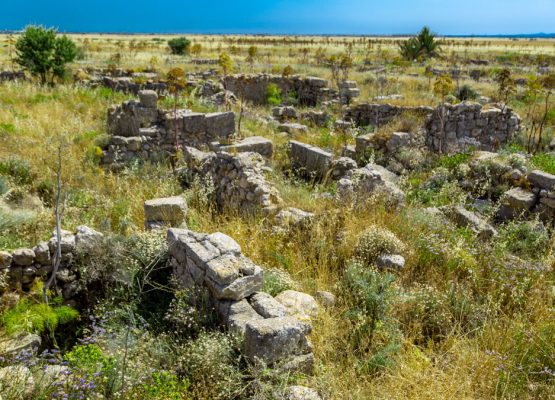
Middle Bronze Age City
This antique city is the site of what is thought to have been the first capital of the island with origins dating back to 2000 BCE.
Enkomi, also referred to as Alasiya, is located near to the present-day village of Tuzla, north of Famagusta.
Excavations have revealed that the city was initially under the influence of Egypt and later of Mycenae – a large orderly city with a prosperous trade, surrounded by fortified walls.
The original settlement was on a rocky plateau west of Tuzla, on the north bank of the river Pedieos, the longest waterway in Cyprus. Copper ore was transported to Enkomi, where it was smelted and shipped for export. At this time, the river was navigable and Enkomi had an inland harbour.
Metallurgical techniques continued into the Late Bronze Age, during which time correspondence between the Pharaoh and the King of Alasiya is recorded. It is unclear whether Alasiya refers to Enkomi, the region or to Cyprus as a whole – however the exchange reveals that Alasiya was a major supplier of copper to Syria and Anatolia, and excavations here have discovered several areas of the city where metallurgy took place. Furthermore, the name is found on texts written in Egyptian, Hittite, Akkadian, Mycenean and Ugaritic.
Much of what can be seen today is the remains of reconstruction of the town after it was devastated by the “Sea People” in around 1200 BCE, aggressive seafarers who invaded eastern Anatolia, Syria, Palestine, Cyprus, and Egypt toward the end of the Bronze Age.
The earlier town had been built on an ad hoc basis, but after the invasion the new town was rebuilt on a grid system, with long east-west avenues and a perpendicular main street. Older structures and tombs were covered over or removed.
It continued to be inhabited until around 1000 BCE, when it was hit by the silting up of its inland harbour on the Pedieos River, and previously by an earthquake in 1075 BCE. As Enkomi declined, the nearby city of Salamis began gradually to thrive, and the last inhabitants of Enkomi migrated there.
Most of the surviving ruins today are from the rebuilt city, which never really recovered its ancient grandeur. Several objects have been since discovered from the site, the majority in 1896 as part of the Turner Bequest expedition to Cyprus, the first excavations on the island conducted by the British Museum.
Two solid bronze statues of gods have been found in the remains of what are thought to be ceremonial buildings on the west side of the main north-south street in the town. The so-called “horned god”, a bronze statuette which reveals the influence of Hittite art, depicting a deity possibly that of Apollo, wearing a horned helmet – and the “ingot god”, a statue wearing a horned conical hat and greaves, armed with shield and spear, and standing on a miniature hide-shaped ingot.
Other notable finds include the decorated “Enkomi Cup” which has been controversially claimed to use niello decoration, which would make it one of the earliest uses of this technique – a black mixture, usually of sulphur, copper, silver, and lead, used as an inlay on engraved or etched metal, especially silver.
Most discoveries have been brought together as a collection of 1,800 objects or fragments in the British Museum in London, from this important Late Bronze Age town of Enkomi in North Cyprus.
Definitely worthy of a stop over if visiting the other major sites in the vicinity.

